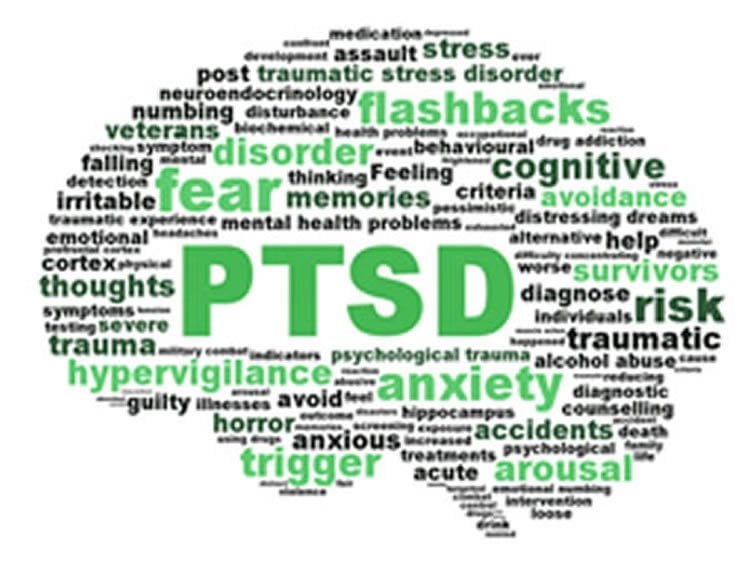Summary: During times of mental stress, young veterans with PTSD show increased ‘fight or flight’ response, a new study reports.
Source: The Psychological Society.
Young veterans with combat-related post-traumatic stress disorder (PTSD) have an increased ‘fight or flight’ response during mental stress, according to new findings published this week in the Journal of Physiology.
The team at Emory University School of Medicine, led by Dr Jeanie Park, believe that this contributes to the increased risk of high blood pressure and heart disease in PTSD patients.
PTSD is prevalent in both military and civilian populations. The lifetime prevalence of PTSD in US adults is 7.8% and around 14% in post-9/11 veterans. PTSD patients are known to have a higher risk for developing high blood pressure and cardiovascular disease.
The researchers also found that veterans with PTSD had higher adrenaline levels and less control of their heart rate in response to blood pressure changes. While previous studies have suggested that the sympathetic nervous system- the ‘fight or flight’ response- of veterans is overactive, this study was the first to measure this increased activity directly and provide a potential mechanism behind this response.
Dr Park and her team took these measurements while the participants experienced two types of mental stress. First-person war images and sounds shown through virtual reality goggles recreated mental stress related to PTSD. Mental arithmetic elicited mental stress un-related to PTSD.

They studied the physiology of post-9/11 veterans, 14 of whom had PTSD and 14 who did not. They measured blood pressure, performed an electrocardiogram (EKG), and recorded sympathetic nerve activity directly in real-time using electrodes placed inside a large nerve. This technique is called microneurography and is considered the gold-standard method for assessing sympathetic nervous system activity in humans.
Commenting on the study, Dr Park said: ‘To protect patients against high blood pressure and heart disease, we need to first understand how their physiology malfunctions. We can then identify potential treatments.’
‘This study looked specifically at veterans with combat-related PTSD, so the findings do not necessarily apply to non-veterans with PTSD, nor to patients with non-combat-related PTSD,’ she added.
Source: Julia Turan – The Psychological Society
Image Source: NeuroscienceNews.com image is in the public domain.
Original Research: Abstract for “Baroreflex dysfunction and augmented sympathetic nerve responses during mental stress in veterans with posttraumatic stress disorder (PTSD)” by Jeanie Park, Paul J. Marvar, Peizhou Liao, Melanie L. Kankam, Seth D. Norrholm, Ryan M. Downey, S. Ashley McCullough, Ngoc-Anh Le, and Barbara O. Rothbaum in Journal of Physiology. Published online May 14 2017 doi:10.1113/JP274269
[cbtabs][cbtab title=”MLA”]The Psychological Society “Veterans With PTSD Have An Increased ‘Fight or Flight’ Response.” NeuroscienceNews. NeuroscienceNews, 15 May 2017.
<https://neurosciencenews.com/fight-flight-ptsd-6682/>.[/cbtab][cbtab title=”APA”]The Psychological Society (2017, May 15). Veterans With PTSD Have An Increased ‘Fight or Flight’ Response. NeuroscienceNew. Retrieved May 15, 2017 from https://neurosciencenews.com/fight-flight-ptsd-6682/[/cbtab][cbtab title=”Chicago”]The Psychological Society “Veterans With PTSD Have An Increased ‘Fight or Flight’ Response.” https://neurosciencenews.com/fight-flight-ptsd-6682/ (accessed May 15, 2017).[/cbtab][/cbtabs]
Abstract
Baroreflex dysfunction and augmented sympathetic nerve responses during mental stress in veterans with posttraumatic stress disorder (PTSD)
Posttraumatic Stress Disorder (PTSD) is associated with increased cardiovascular (CV) risk. We tested the hypothesis that PTSD patients have augmented sympathetic nervous system (SNS) and hemodynamic reactivity during mental stress, and impaired arterial baroreflex sensitivity (BRS). 14 otherwise healthy Veterans with combat-related PTSD were compared to 14 matched Controls without PTSD. Muscle sympathetic nerve activity (MSNA), continuous blood pressure (BP), and electrocardiography were measured at baseline, and during two types of mental stress: combat-related mental stress using virtual reality combat exposure (VRCE); and noncombat related stress using mental arithmetic (MA). Cold pressor test (CPT) was administered for comparison. BRS was tested using pharmacologic manipulation of BP via the Modified Oxford technique at rest and during VRCE. Blood samples were analysed for inflammatory biomarkers. Baseline characteristics, MSNA and hemodynamics were similar between the groups. In PTSD versus Controls, MSNA (+8.2 ± 1.0 vs +1.2 ± 1.3 bursts/min P < 0.001) and heart rate (HR) responses (+3.2 ± 1.1 vs −2.3 ± 1.0 beats/min, P = 0.003) were significantly augmented during VRCE. Similarly, in PTSD versus Controls, MSNA (+21.0 ± 2.6 vs +6.7 ± 1.5 bursts/min, P < 0.001) and diastolic BP responses (+6.3 ± 1.0 vs +3.5 ± 1.0 mmHg, P = 0.011) were significantly augmented during MA, but not during CPT (P = NS). In the PTSD group, sympathetic BRS (-1.2 ± 0.2 vs -2.0 ± 0.3 BI mmHg−1, P = 0.026) and cardiovagal BRS (9.5 ± 1.4 vs 23.6 ± 4.3 ms mmHg−1, P = 0.008) were significantly blunted at rest. PTSD patients had significantly higher hs-CRP levels compared to Controls (2.1 ± 0.4 vs 1.0 ± 0.3 mg L−1, P = 0.047). Augmented SNS and hemodynamic responses to mental stress, blunted BRS, and inflammation may contribute to increased CV risk in PTSD.
“Baroreflex dysfunction and augmented sympathetic nerve responses during mental stress in veterans with posttraumatic stress disorder (PTSD)” by Jeanie Park, Paul J. Marvar, Peizhou Liao, Melanie L. Kankam, Seth D. Norrholm, Ryan M. Downey, S. Ashley McCullough, Ngoc-Anh Le, and Barbara O. Rothbaum in Journal of Physiology. Published online May 14 2017 doi:10.1113/JP274269







